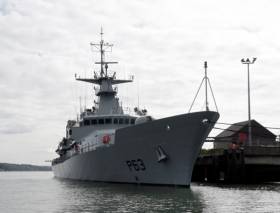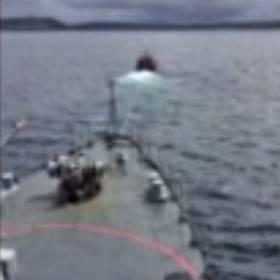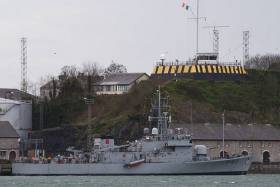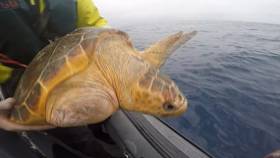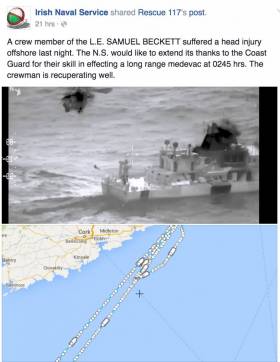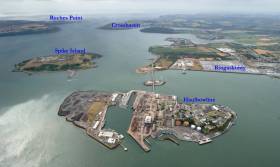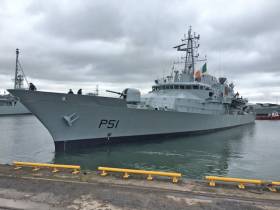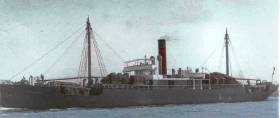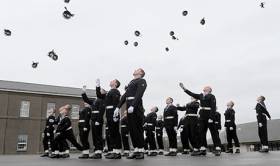Displaying items by tag: naval service
Newest Naval Service Vessel To Be Twinned With Galway Next Month
#Navy - Taoiseach Enda Kenny will officiate the twinning of the new Naval Service vessel LÉ William Butler Yeats with the city of Galway on Monday 17 October, as the Connacht Tribune reports.
The City of the Tribes was previously linked with the LÉ Aisling, which was decommissioned this past summer and is now being proposed as the home of a floating museum in Galway Docks.
Designed by Vard Marine and built by Babcock Marine in Appledore, north Devon, LÉ William Butler Yeats is in the same class OPV90 as sister ships LÉ Samuel Beckett and LÉ James Joyce, delivered in 2014 and 2015 respectively.
On a visit to the new vessel in Haulbowline last month, Defence Minister Paul Kehoe described its arrival and entry into service as "another key milestone in the history of the Naval Service".
Clifden Lifeboat Tows Naval Vessel In Training Exercise
#RNLI - An unusual training exercise took place on Sunday (14 August) off the Connemara coastline involving the Naval Service vessel LÉ Orla and the volunteer crews of the Clifden RNLI lifeboats.
In calm conditions, RNLI volunteers and naval crew co-operated on a number of training exercises, beginning with a 'man overboard' scenario, in which the casualty was transferred by hoist from the LÉ Orla to the Mersey class all weather-lifeboat Fishermans Friend.
A RIB from the naval vessel was then recovered in the water and towed by the Atlantic 85 lifeboat helmed by Daniel Whelan with crew John Mullen, Gerry Claffey and Michael Carey.
Next up was a salvage operation exercise, where the lifeboat crew used their salvage pump onboard the Naval vessel which was supposedly adrift at the time.
"It was at this point it occurred to me that as part of a salvage operation we would normally tow the vessel in question," said Clifton RNLI coxswain David Barry, who requested and was granted permission to tow the 750-tonne OPV at 1,500 revs and 3.2 knots.
"Admittedly, conditions were very calm at the time, but we were all really delighted to have been able to successfully carry out a brief tow," he added. "In poorer conditions, we might have been able to at least keep the ship nose to sea.
"Overall, the day's exercises were a huge success for the whole crew and we are really grateful to the Irish Naval Service for facilitating these invaluable exercises."
To round off the exercise session, three Naval Service divers were recovered from the water by both lifeboats.
Since the introduction of the all-weather lifeboat to Clifden, the volunteer crew have undertaken many hours of advanced and innovative exercise scenarios intended to give the crew experience and competence.
#Angling - The 1st Meath Adventure Scouts from Dunboyne and Sphere 17 youth group from Darndale in north Dublin recently participated in a visit on board the Irish Naval Service vessel LÉ Ciara.
During a short break in Dublin Port to refuel on 25 July, the ship's commanding officer gave kind permission for a visit on board, which was facilitated by the Dublin Angling Initiative (DAI) of Inland Fisheries Ireland (IFI).
The two youth groups were given a comprehensive tour of the ship, which included talks on naval duties, life at sea, navigation and weapon systems, fisheries protection and naval recruitment opportunities.
A key component of the DAI is to highlight the importance of fisheries conservation, and the initiative says visits aboard Irish naval ships are an extension of that sector.
DAI co-ordinator Oisin Cahill said: “We are delighted to work with the young people and youth leaders from 1st Meath Adventure Scouts and Sphere 17 Darndale. It is great to see the youth groups engage on the issue of conservation through enjoyable and interesting experiences such as this one.
"The Dublin Angling Initiative also introduces youths to the pursuit of angling. Angling is a wide and varied pursuit which can be sedentary or active, practiced socially or in solitude and appeals to a wide range of people of all ages including young people.
"We hope that by introducing these young people to angling, it might spark their interest and lead to them pursuing it as a hobby. It is vital that we engage communities around the aquatic landscape and encourage interest in important issues such as conservation and the environment.”
The DAI aims to promote, develop and improve angling in the greater Dublin area. During the summer months, young people from national and secondary schools, summer projects and youth services are taken out on fishing courses.
To date, thousands of young people have been introduced to sea, coarse and game angling, and the initiative has been a catalyst in setting up fishing clubs for many of these young people.
The DAI welcomes enquiries from all groups or individuals interested in its programmes and services. For further information visit www.fisheriesireland.ie or contact Oisin Cahill at [email protected].
#Turtles - Two rescued loggerhead turtles have been returned to the ocean by the crew of LÉ Róisín as the Naval Service vessel makes its way to the Mediterranean on deployment.
According to RTÉ News, the Naval Service were only happy to oblige when contacted by Dingle Oceanworld about the possibility of releasing Una and Tallula.
The former was nursed back to health at the Dingle marine wildlife sanctuary after she was found at Barryroe in West Cork last December.
LÉ Róisín releases rescued turtles while en route to Mediterranean (Vid:Irish Naval Service) https://t.co/yyrasAbj23https://t.co/xJ8iSENsdr
— RTÉ News (@rtenews) May 5, 2016
She was joined on the OPV by Tallula, a turtle washed up in Cornwall who was treated at Newquay's Blue Reef Aquarium and flown into Dingle especially for release.
As previously reported on Afloat.ie, LÉ Róisín and its 57-strong crew are headed to the Mediterranean as the first deployment for the Naval Service this year under Operation PONTUS.
#CrewInjury - The Naval Service has thanks to the Irish Coast Guard’s Shannon and Waterford helicopter crews for their assistance in an early morning (Tuesday) medevac from one of their vessels.
The Clare Herald writes that a crew member on board the L.E. Samuel Beckett was airlifted to hospital in the early hours after suffering an injury on board.
Irish Coast Guard search and rescue helicopters from Shannon and Waterford were involved in the operation.
The Naval Service has confirmed that a crew member on board the Samuel Beckett suffered a head injury in an ‘offshore’ incident. The accident happened at around 1.00am about 120 kilometres south of Cork.
To read more of the newspaper's coverage click here.
“The boy stood on the burning deck,” is one of the most famous lines in literature and particularly relevant in the maritime sphere. Many people can quote the next line…”Whence all but he had fled…” But why was he there, on what ship and in what circumstances? On this week’s edition of THIS ISLAND NATION we tell you the full story. While listening to it, I compared it with a following story on the programme, the threat to the operations of the Irish Naval Service by a commercial company.
It seems ludicrous that a fully operational Naval Service is under threat, but so it is and the warning has come from the Department of Defence, so it is the opinion of Government.
“This cannot be an acceptable situation….for the necessary functioning of a fully operational Naval Base…..” Those words, from the Department of Defence, are blunt and were made in a major intervention at a public inquiry held by Bord Pleanala into the Indaver Ireland waste company’s third attempt to build a hazardous waste incinerator at Ringaskiddy in Cork Harbour, close to Naval Base headquarters. The Department went further, stating that the location of the incinerator would also affect Air Corps operations, which “may be forced to impose a ‘no-fly’ restriction” around Haulbowline Island. “In addition, Haulbowline Island is accessed by road as a sort of cul de sac to the Ringaskiddy Road. The proposed incinerator is to be built adjacent to this road, before Haulbowline. Therefore, in the event of any accident at the incinerator, road access to and from Haulbowline is threatened. For example, if an accident at the incinerator necessitated local area evacuation, the evacuation of Haulbowline would be denied.
“This cannot be an acceptable situation for those that work at or visit Haulbowline, nor for the necessary functioning of a fully operational Naval Base therein.”
That makes the threat to the Naval Service very clear. No nation can accept a restriction imposed on its Naval Service operations. That must be national policy. I am proud of our Naval Service. It is a professional, top-level maritime organisation. Its rescue work in Irish waters has been superb. Its performance on refugee rescue in the Mediterranean has raised the profile of Ireland as a maritime nation. I do not accept that its operations should be threatened. I live in the Cork Harbour area. Through my kitchen window I see three wind turbines and several chemical factories. So harbour industrial development is an accepted part of my daily life, but a threat to our Naval Service is not acceptable.
Also under threat, publicly stated by the Minister for the Marine, is €500m. of marine development investment in the harbour if the incinerator, which he has described as “wrong place, wrong time,” is built. Concern has been voiced about youth sailing close to the incinerator and, if Air Corps helicopter operations are affected, what about the effect on Coast Guard helicopter operations in the area?
This is the 50th edition of THIS ISLAND NATION so a somewhat unusual coincidence of two Naval stories on the programme - that of the legendary boy who stood on the burning deck of the flagship of Napoleon’s fleet at the Battle of the Nile, the three-decked, 120-gun L’Orient and the threat to Ireland’s Naval Service
• Listen to the programme below:
L.É. Róisín Leaves For Latest Mediterranean Mission
#Roisin2Med - LÉ Róisín has departed Naval Base at Haulbowline this afternoon (Sunday 1 May) for Ireland's latest search and rescue mission in the Mediterranean.
As previously reported on Afloat.ie, LÉ Róisín follows last year's humanitarian missions by LÉ Eithne, LÉ Niahm and LÉ Samuel Beckett in the Mediterranean, where between them they rescued more than 8,500 migrants.
The latest mission, in conjunction with Italian authorities, sees a 57-strong crew set sail today for the Mediterranean as the first deployment for the Naval Service this year under Operation PONTUS.
LE Roisin slipping and proceeding from Haulbowline en route to Med Search and Rescue mission this afternoon pic.twitter.com/am5WuDhish
— Irish Defence Forces (@defenceforces) May 1, 2016
An Island Nation – But Not Yet A Maritime One!
I love Irish history. It is the story of the Irish people, living in an island nation. But I have always wondered about a maritime, a shipping aspect of the Easter Rising, the commemoration of which has raised the profile of our evolution as an independent country. And that is – would it actually have been possible for the AUD, the German ship with weapons and ammunition for the Irish Volunteers, by arrangement with Roger Casement, to have landed its cargo in Tralee Bay, which is the accepted historical conception of that part of the plans for the Rising.
I have always wondered about the challenge and difficulties of getting 20,000 rifles, 10 machine guns and 3.5 million rounds of ammunition off that ship in the conditions and shipping facilities of Tralee Bay and the probably only realistic landing site at Fenit in 1916.
Was it to have been done at Fenit? In the facilities there for unloading in 1916 would that actually have been possible? Was it thought that the cargo might be got off into open boats in the Bay?
I got my opportunity to ask that question of an expert on the period last weekend, Dr. John Treacy, who was recently awarded his Ph.D. from Mary Immaculate College in Limerick for his doctoral thesis about the Naval Service.
He answered me very directly: “I would say absolutely not.”
He had a lot more to say about the AUD and the plan for it to provide weaponry for the Volunteers when I interviewed him at a seminar which underlined the huge public interest in Irish maritime affairs. “Revolution on an Island -The Maritime Aspects of the 1916 Rebellion,” was organised by the Irish Maritime Forum. It was booked out. People attended from all over the country. There was even a waiting list for places at the National Maritime College in Ringaskiddy on the edge of Cork Harbour where it was held.
Dr. Treacy spoke on ‘The Silent Shore – The Attempt to land arms at Banna Strand from the AUD.” It is a fascinating part of Irish history and the maritime involvement. If you have any interest at all in our history, I urge you to listen to him below on my programme, THIS ISLAND NATION.
It was also an unusual experience for me at that seminar to find myself being quoted at the outset. It was for my description of Ireland as an “island nation” which is accepted by the Forum, which is an independent think-tank on maritime matters. But the Forum had a qualification – “Ireland is not yet a maritime nation”
You can hear more about this from retired Naval officer, Capt. James Robinson, who discusses it with me on behalf of the Forum. Not a lot has been heard about the Forum in public, but this seminar was a revelation.
Simon McGibney, the new Commodore of the Irish Cruiser Racing Association, talks to me about his plans for this year’s sailing and the retirement of one of the country’s longest-serving lifeboatmen, from the RNLI Rosslare Station, is reported while there is also good advice on the programme about using vehicles to launch and recover boats from slipways in view of the Buncrana tragedy.
THIS ISLAND NATION reports on the marine traditions, culture, history and modern maritime developments of our island nation. I hope you enjoy it and would welcome your comments. You can Email to: [email protected]
Naval Service Recruit Class 'Sweeney' Passing Out
#Recuits - The Naval Service Recruit Class 'Sweeney' commenced training in October 2015. A passing out parade today will mark the culmination of their training and successful entry into the Naval Service at the rank of Ordinary Seaman.
In total the 39 recruits are drawn from 14 different counties, 2 of whom are originally from the UK. They range in age from 18 to 27 and have completed numerous modules during their 5 months extensive training, including weapons training, foot drill, arms drill, navigational training, medical training and of course seamanship. Special awards will be given for Best Shot, Best Kit and Best Recruit.
The class is named 'Sweeney' after Ted Sweeney, the Irish Coast Guardsman and Blacksod lighthouse keeper who on June 3, 1944 delivered a weather forecast by telephone from Co Mayo’s most westerly point. The report convinced General Dwight D Eisenhower to delay the D-Day invasion for 24 hours, potentially averting a military disaster and changing the course of WW2. Classes are named in honour of significant people in maritime history. Ted Sweeney’s son Edward will be present on the day and a presentation will be made. Edward Sweeney will be accompanied by his wife Rita.
Recruit Class Sweeney raised €6,050 from a rowathon in aid of the Baby Lexie O’Riordan Foundation. Lexie O’Riordan & her parents Sylvia & Ed will be present on the day and the cheque will be presented. Members of the class were also involved as models for the Brave Men Walking charity event, in aid of the Irish Cancer Society and Breakthrough Cancer Research. They also participated in the Christmas fun run on the Naval Base in aid of Build for Life Cystic Fibrosis.
The Naval Service in 2015: Operations at Home & Overseas
#Navy2015- The humanitarian crisis that unfolded earlier this year, led to three Irish Naval Service ships deployed under 'Operation Pontus' to the Mediterranean supporting the Italian Marine Rescue Co-Ordination Centre with Search and Rescue assistance.
The total number rescued in 2015 by the men and women of Óglaigh na nÉireann was 8,631, sadly 39 bodies were also recovered. The Naval Service, on behalf of the Defence Forces, received the People of the Year Award for the mission in the Mediterranean in 2015.
Fisheries
Domestically, provisional figures indicate that the Naval Service has completed 1076 boardings and made 10 detentions so far in 2015 for alleged infringements of fishing regulations during their 1205 patrol days.
The Naval Service patrols 220 million maritime acres of sea (over twelve times the land mass of Ireland) representing 15% of Europe’s fisheries. Fishing vessels from Ireland, United Kingdom, France, Spain, Germany, Netherlands, Norway, Russia, Belgium and Denmark were boarded and inspected in 2015.
Specialist Dive Team Operations
The Specialist Naval Service Dive Team was deployed to 43 operations so far this year. Military Operations include underwater maintenance of Naval Service Fleet, sub-surface explosive ordnance disposal operations and berth clearances for visiting foreign warships.
The Naval Service Dive Team has been involved in 9 separate Search and Recovery operations following requests from the Coast Guard and An Garda Síochána, many of these operations lasting several days. The remains of six (6) individuals have been recovered in the process of these searches this year and returned to their loved ones.
They have also carried out four (4) searches on behalf of Customs & Excise, searching the hulls of suspect vessels entering our ports and conducted security/ berth clearance dives for visiting naval ships. This year the Naval Service Diving Section assisted with the annual conference for IDSA (International Diving Schools Association), which qualifies Naval Divers commercially in SCUBA and Surface Supplied Diving Equipment (SSDE).
Training Education and Innovation
The exchange programme with the Royal Canadian Navy (RCN) continued where RCN Officers embark on Naval Service vessels, honing their seamanship skills, primarily in the area of coastal navigation.
This mutual exchange programme has seen Irish Naval Officers undergo Fleet Navigation and Mine Clearance Diving Officer courses in Canada during 2015.
Training support was provided to the Maritime Squadron from Malta in preparation for the successful handover / takeover of the (former) Irish Naval Service vessel the LÉ Aoife (P22).
This training support will continue into 2016. As per the UK/Irl Bilateral Agreement on Defence Cooperation (signed in Jan 2015), training exchange initiatives were undertaken with the UK Royal Navy to increase inter-operability and these will continue in 2016.
Educational initiatives during 2015 focused on meeting the requirements of our new ship technologies and on bringing leading edge research at the National Maritime College of Ireland (NMCI) into the classroom.
The ‘Aeolus 1’ and ‘Aeolus 11’ research projects focusing on the use of kite technology at sea continue to progress in cooperation with the Halpin Research Institute, NIMBUS centre and IMERC (Irish Maritime Energy and Resource Cluster) partners.
Harnessing our Ocean Wealth (HOOW) ‘Seafest’ was hosted in July in collaboration with the Marine Institute and CIT and this also included the opening of the UCC Beaufort Centre in Ringaskiddy. HOOW encompassed more than 150 maritime industrial, commercial, academic and research partner’s interacting to promote national and international maritime development for Ireland. An estimated 8,500 members of the public also attended the event. The Beaufort Centre incorporates the largest seawater test tanks in Europe and houses over 120 top-level maritime energy researchers.
The Naval Service, as a partner in IMERC, was pleased to note the opening in 2015 of the EntrepreneurShip, a business incubation hub in IMERC, designed to support and spin-out/ spin –in business enterprises related to the research and maritime innovation with which the NS is involved.


























